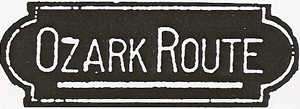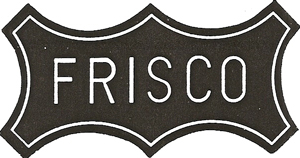 |
Ozark & Cherokee Central |
 |
History
The Frisco tracks had hardly reached Fayetteville before talk began in Prairie Grove about building track to Fayetteville to connect with the Frisco. Articles appeared in the local newspaper on Sept. 26, 1885 and again Jan. 10, 1886. These articles talked about rails being in place in one year. There was a formal RAIL ROAD MEETING on Sept. 25, 1888 to discuss the possibility of building a railroad. The nursery and apple industries needed a rail connection to ship their products. It took the interest of Mr. J. H. McIlroy of Fayetteville to finally bring it about. Remember it was Mr. McIlroy who ram rodded the building of the University of Arkansas in Fayetteville. The North Arkansas and Western Railroad was chartered in the state of Arkansas Nov. 29, 1899 to connect Fayetteville, AR with the Illinois River Valley in Indian Territory. It was reported in the March 8, 1901 issue of Railway Age that construction of a standard gauge railroad was begun west out Fayetteville under the name of North Arkansas and Western. After the completion of 12 miles of right-of-way to Prairie Grove, it was sold to parties who could financially complete the project. H. W. Seaman of Clinton, IA was elected president, E. E. Hughes vice-president, and M. A. Cooper Secretary-Treasurer. A contract was drawn with the Kenetick Construction Company of Kansas City, MO, William Kenefick president, to complete the total of 70 miles from Fayetteville to Tahlequah, OK. At the time of the report, track laying was awaiting the delivery of the rail. The report also stated that either Stillwell or Westville would be the connection with the Kansas City Southern (Westville was chosen). The name was expected to be changed to Ozark & Cherokee Central and the line continued to Tahlequah and Muskogee after contracts were drawn. Headquarters for the railroad and its construction were headquartered in Fayetteville. The new Ozark and Cherokee Central Railway was a short line that was constructed starting in 1901 to run from the Frisco line in Fayetteville, Arkansas to Okmulgee in Indian Territory. The line was constructed using convict labor, mostly black, in Arkansas and Cherokee and Greek laborers in Indian Territory. Its purpose was to tap the rich timber and fruit growing area of the Illinois River Valley. In the early days, train loads of apples and strawberries were shipped on the line. In the latter years nursery products were a significant part of the business. The first train operated into Fayettville on August 22, 1901. Passenger trains first operated from the O&CC's own station at Prairie St. Later they operated from the Frisco station on Dickson Street in Fayetteville. They then used their own right-of-way down grade to where it crossed under the Frisco on its way west. The first train arrived in Prairie Grove on Aug. 31, 1901. The first train entered Lincoln, Arkansas on January 22, 1902. In late March 1902 a second rail line, began operations through Westville, giving the town an enviable position at a rail junction. The end of track reached Welling on July 12, 1902. The last rail to reach the Tahlequah, OK depot was laid on Aug. 2, 1902. The first train arrived from Fayetteville on Aug. 5, 1902 with 800 passengers in 8 cars, two cars owned by O&CC and 6 borrowed from the Frisco. With the completion to Prairie Grove, train loads of apples and strawberries began to be shipped. Stark Bors. Nursery of Farmington became an important shipper along the line. This company suffered when the line was later abandoned and went out of business in the 1970s. The timetable from August 11, 1902 showed daily service to Tahlequah, IT. The line to Okmulgee was still under construction. It was completed into Fort Gibson on Dec. 10, 1902 and Muskogee on Feb. 1, 1903 after the completion of the steel bridge over the Arkansas River. The bridge was owned by the Muskogee City Bridge Co. The line was completed to Okmulgee in March 13, 1903 by the Shawnee, Oklahoma & Missouri Coal and Railway Company. With the arrival of the railroad, it became possible to ship heavy equipment to Tahlequah. This resulted in the construction of public water works, a light plant, an ice and cold storage plant, and a steam power gotten gin. A grain elevator was built near the depot. The cotton gin and grain elevator led to the shipment of car loads of cotton and wheat. The Ozark and Cherokee Central was leased by the Frisco in July 1, 1903. Then on July 15, 1907, the O&CC sold its stock to the Frisco. According to a Fayetteville newspaper clipping, the O&CC painted its passenger cars olive and yellow. The Ozark and Cherokee Central Annual report for the year ended June 30, 1904: "Ozark and Cherokee Central Railway . This road was built by the Kenefick Construction Comapny and extends from Fayetteville, Ark. to Okmulgee , IT, a distance of 143.90 miles. The Construction Company received $2.880,000 of Ozark and Cherokee Central Railway Company's First Mortgage Five Percent Bonds and $2,880,000 of its capital stock , in payment for construction of the line . This Company [FRISCO] purchased all of the stock and bonds from Kenefick Construction Company and the road was taken over for operation by this Company at July 1st 1903". A 1904 Frisco System Official Railway Equipment Register listing shows the O & CC as a separate entity. The cars were marked "O & CC RR " . The equipment included one coach, No 519, one combination passenger & baggage car and 26 box cars numbered in even numbers only in the 500 to 598 range and ten flat cars , odd numbered only between 501 and 519. Freight trains interchanged with the Frisco at the yard at Fayette Jct. where the St. Paul Branch connected to the main line from Monett, Mo to Paris, TX. According to the November 1929 Public Timetable, see O&CC Timetables, there was through passenger service to Tulsa, OK from Fayettevulle, AR over this line. The 1932 Oklahoma Railroad Map, see O&CC Maps, that hangs in the Three Rivers Museum in Muskogee, OK shows this twisting route of the O&CC Ry from Westville to Okmulgee, OK. In the later years passenger service was provided by a motor car until May 1940 when passenger service ended. The motor car had a RPO section. Most of the 91 miles from Mc Nair, junction with Monett to Paris line, westward to east of Ft. Gibson, OK were abandoned in July 1942. The track was seized by the War Production Authority. The Frisco had requested Interstate Commerce Commission approval in January 1942 to abandon 91.16 miles of the line. The Ft. Gibson Lake project would have inundated 8.25 miles of the line in Oklahoma. Replacement of the track would have cost the Frisco more than $500,000, a sum that made no sense for the money losing Muskogee Sub. The last train on the eastern 91 miles of the line ran July 10, 1942. That train collected all of the materials in stations along the line. Service across the Arkansas River bridge to Ft. Gibson and beyond continued into the 1960s. This bridge had weight restrictions as it was of light-weight pin connected design. As a result smaller locomotives were used on this line until all service was suspended. The line north of Ft. Gibson was used to deliver construction materials for the Ft. Gibson Lake dam about five miles north of Ft. Gibson on the Grand River. This flood control project was begun in 1942 but was suspended during WWII. The project was finally completed in 1953. Completion of this project flooded the right-of-way beyond the dam. Today, State 80 is built over much of the right-of-way up to the dam. The Arkansas River bridge stood unused for several years before being removed as part of the Kerr-McClellan Navigation Project in the late 1960s. It was gone by the time of the completion of the Project in 1968. The line disappeared from official state highway maps between 1979 and 1983. BNSF still serves Muskogee industries but the UP in Muskogee carries the cars to a connection with "home rails" in Tulsa. The line from Ft. Gibson to the east side of the Arkansas River was reconstructed to modern standards and Wyoming coal began to be stockpiled in 1976 for the OG&E Muskogee Power Plant. The track east of the Arkansas River bridge through Ft. Gibson was abandoned in (?) The Arkansas River bridge was removed (?) According to a document entitled "Oklahoma Department of Transportation - Survey Division: Steam or Diesel Powered Railroads Abandoned in Oklahoma as of April 1, 1978", the Muskogee Branch from Muskogee to Okmulgee was abandoned on 10/13/73. Fayetteville End of Line As many of you know, the O.& C.C became part of the
FRISCO, running from the depot in Fayetteville south then
west to Westville, Ok. and beyond. |
This site is maintained by the Arkansas Boston Mountains Chapter of the National Railway Historical Society located in Springdale, Arkansas

Home of THE ARKANSAS SCRAMBLER
For questions, email arkyrail at outlook.com